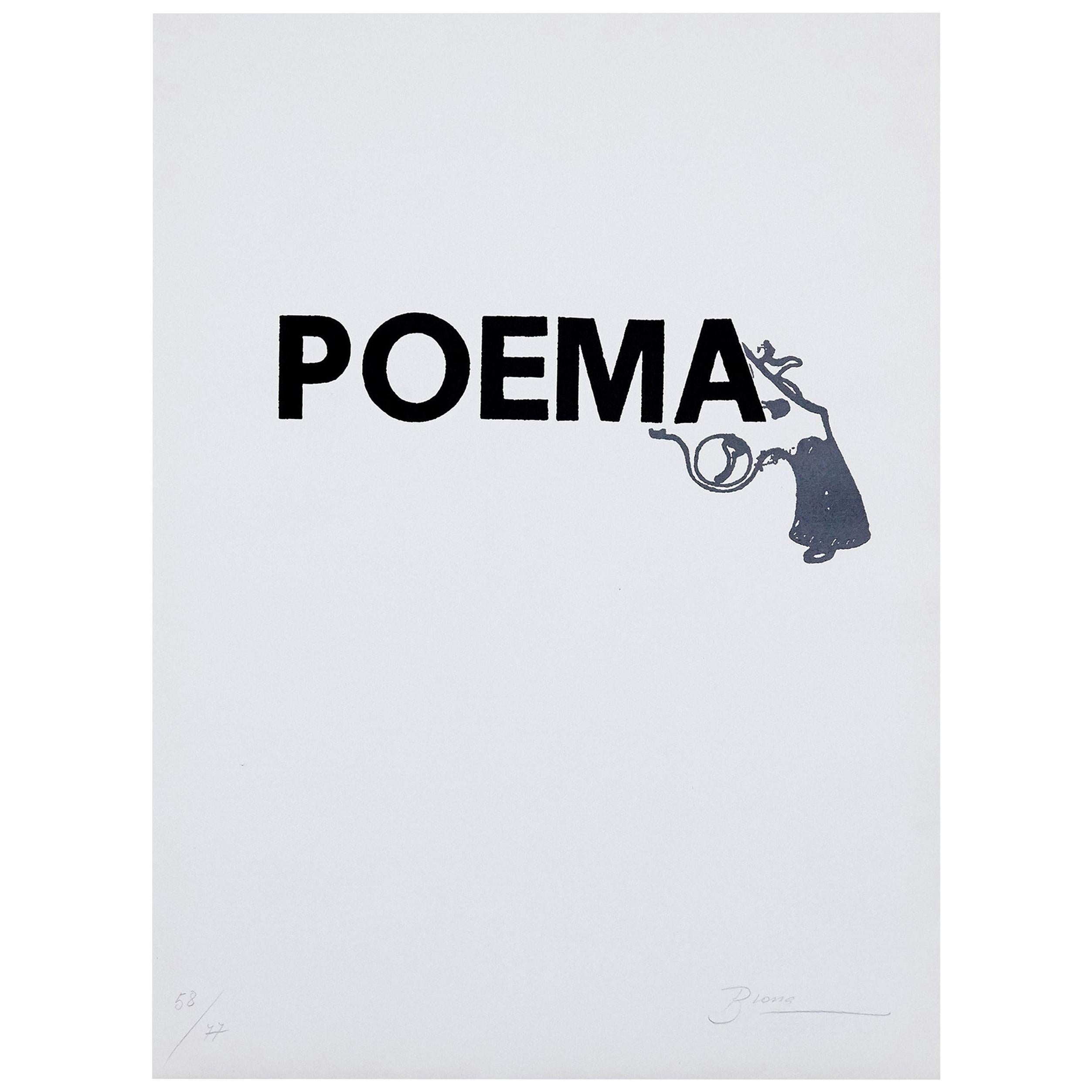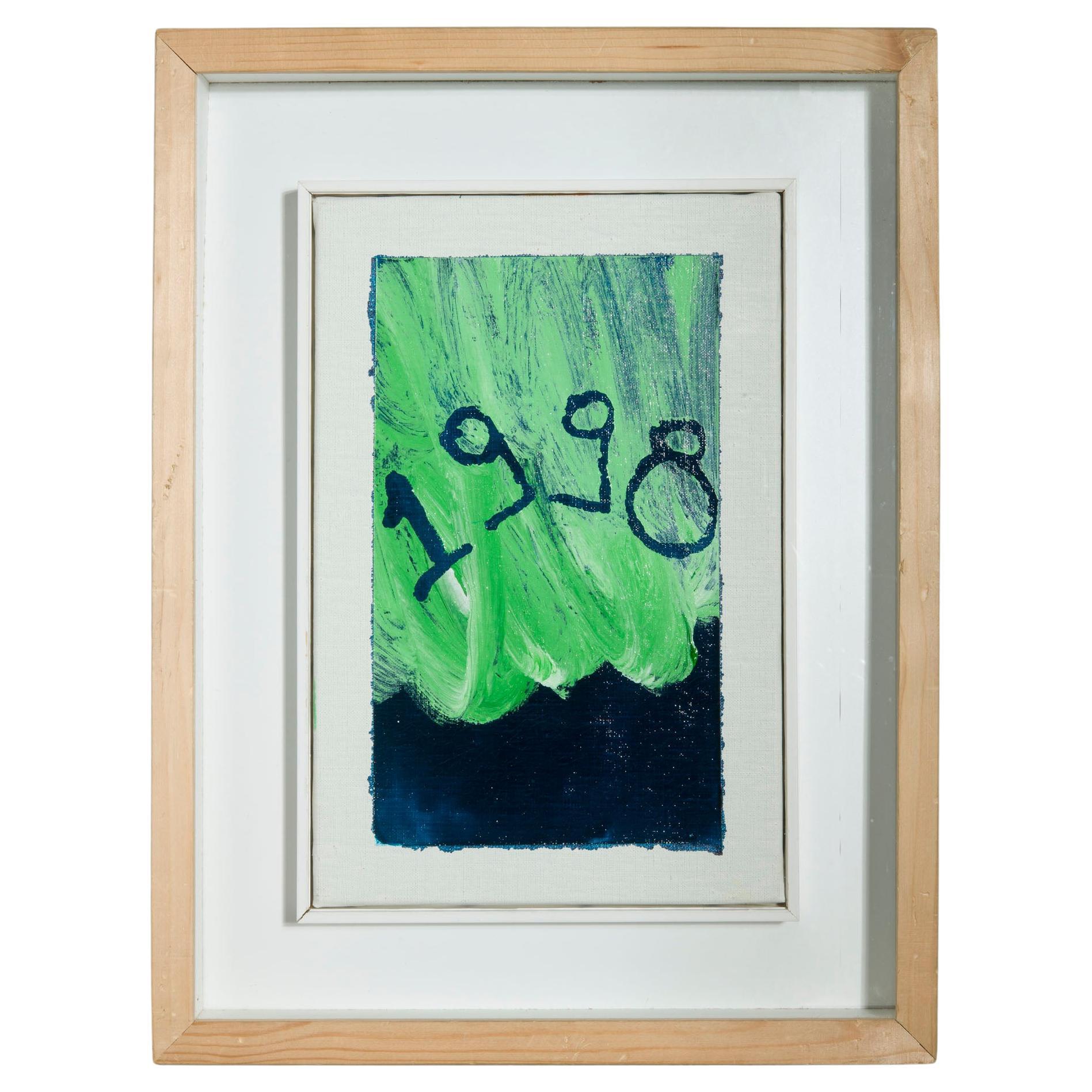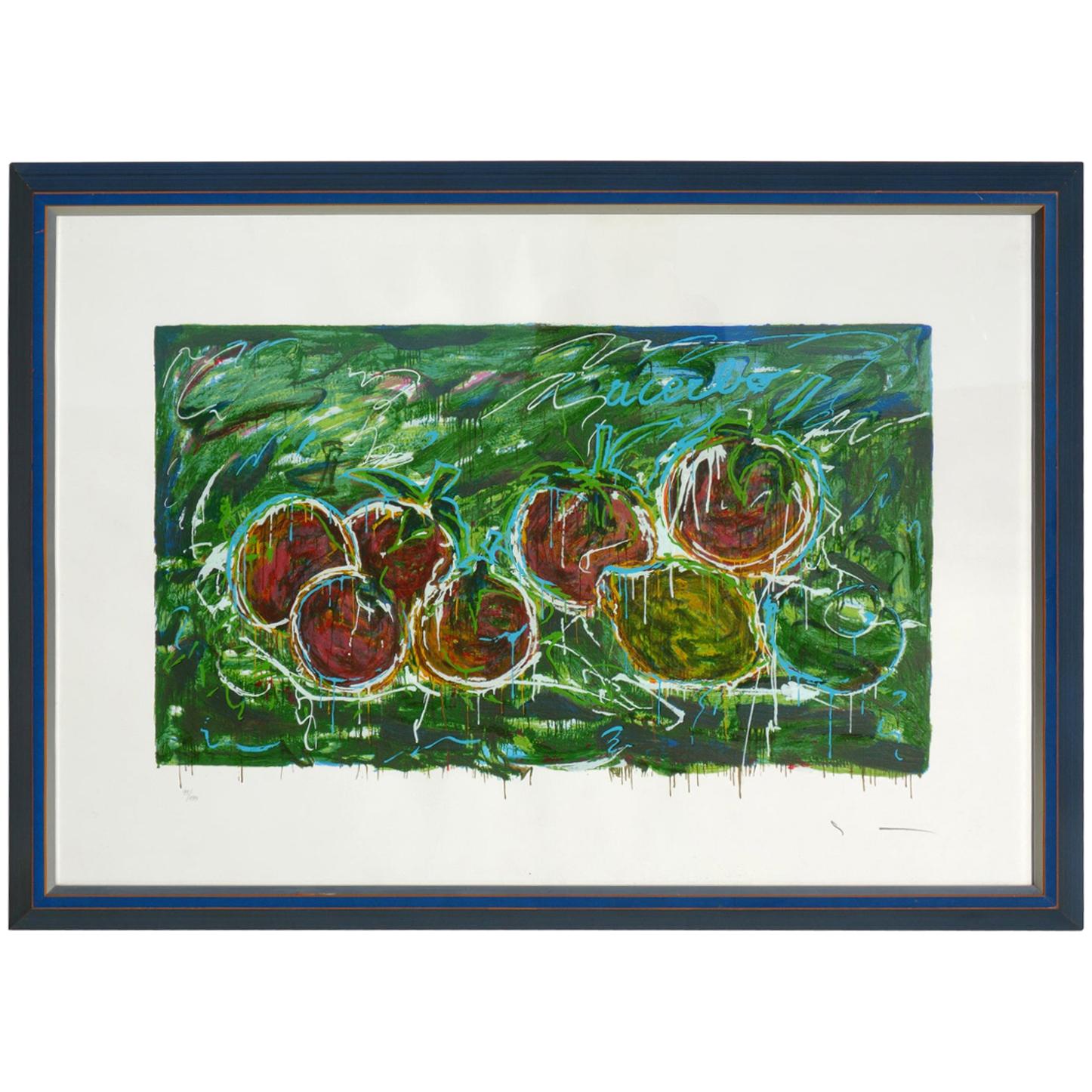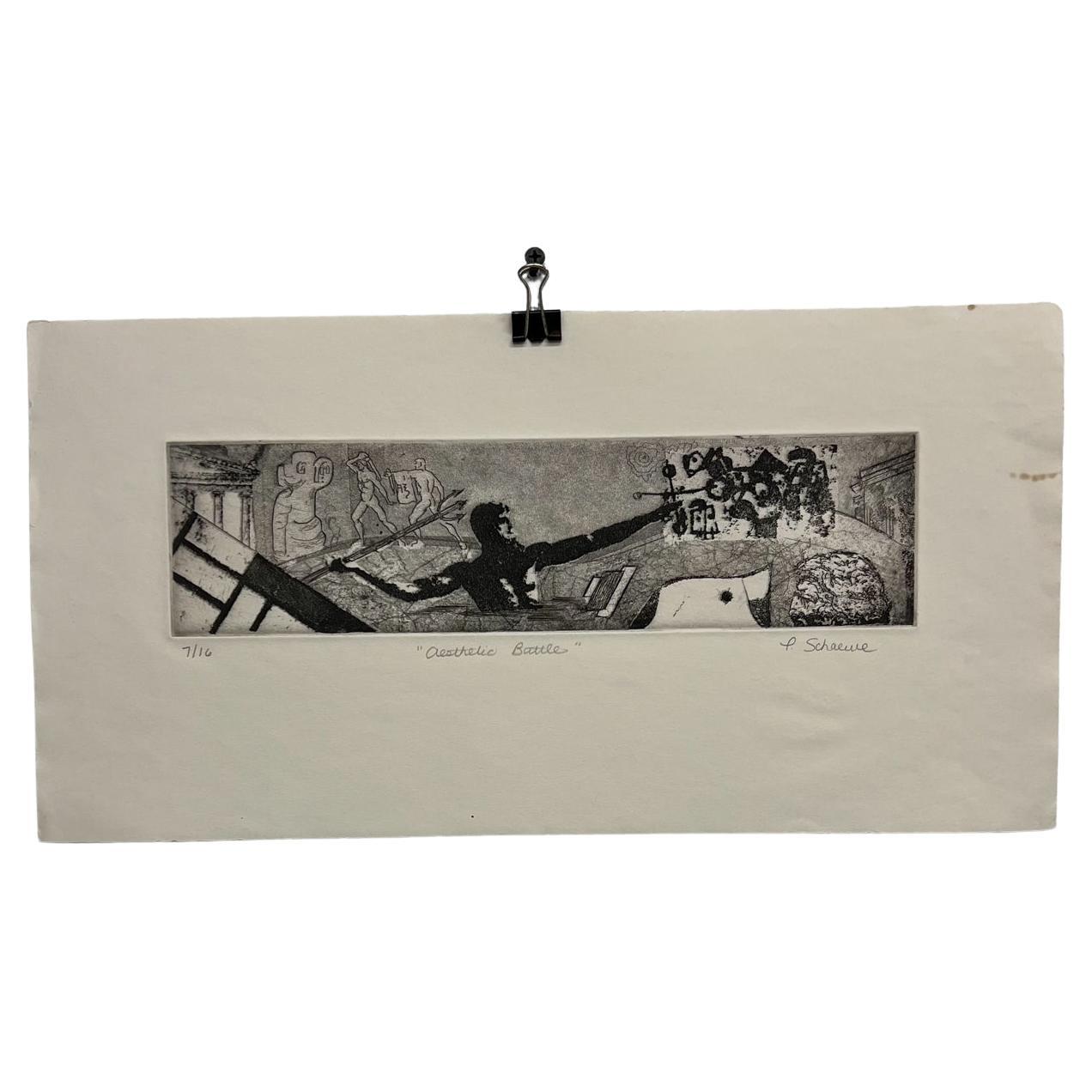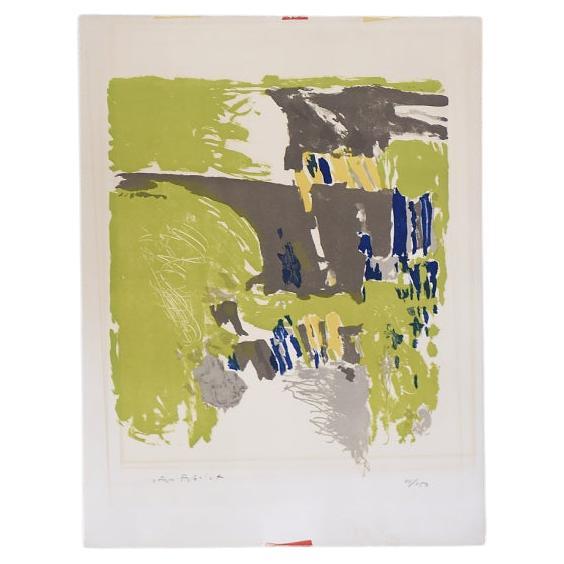Items Similar to 1980s Signed Mario Schifano Artwork on Paper
Want more images or videos?
Request additional images or videos from the seller
1 of 8
1980s Signed Mario Schifano Artwork on Paper
About the Item
Materic silkscreen print “Ondate di gelo” (Frost Waves) by Mario Schifano.
Signature and numbering in pencil on front side.
Dry stamp of the artist on front.
Edition F.C. (Not for sale) 23/30. Framed work.
The artwork for sale is part of the collection 'Best Seller: 31 graphic works by Mario Schifano' edited by Edizioni Torcular Edition on handmade paper with Torcular watermark by Cartiera Magnani of Pescia Printer: Egiziano Piersantini
This artwork, never before on the market, comes from a private collection and is beautified by an impressive original frame in natural wood, in almost perfect condition.
The painting is also protected by glass
Every item of our Gallery, upon request, is accompanied by a certificate of authenticity issued by Sabrina Egidi official Expert in Italian furniture for the Chamber of Commerce of Rome and for the Rome Civil Courts.
Mario Schifano (Homs 1934 - 1998) was an Italian painter and filmmaker.
Together with Franco Angeli and Tano Festa he represented a fundamental point of Italian and European Pop Art.
Perfectly integrated in the international cultural scene of the 1960s, he was reputed to be a prolific, exuberant and drug-addicted artist.
A keen student of new painting techniques, he was among the first to use computers to create works and was able to process images from the computer and transfer them onto emulsified canvases.
Mario Schifano was born in Italian Libya and after the end of the war returned to Rome where, due to his restless personality, he left school early to follow in his father's footsteps who worked at the Etruscan museum of Villa Giulia as an archaeologist and restorer.
Thanks to this experience, he approached art, initially producing works that were influenced by Informal Art.
His first solo exhibition was at the Galleria Appia Antica in Rome in 1959.
In the late 1950s, he participated in the artistic movement Scuola di Piazza del Popolo together with artists such as Francesco Lo Savio, Mimmo Rotella, Giuseppe Uncini, Giosetta Fioroni, Tano Festa and Franco Angeli.
The group met at Caffè Rosati, a Roman café then frequented by Pier Paolo Pasolini, Alberto Moravia and Federico Fellini, among others, and located in Piazza del Popolo, from which they took their name.
In 1960, the group's works were exhibited in a group show at Galleria La Salita.
In 1961 he exhibited in a solo show at Galleria La Tartarugadi Plinio De Martiis in Rome.
In the meantime, he had met, among others, his future lover Anita Pallenberg at the Caffè Rosati, with whom he made his first trip to New York in 1962, where he came into contact with Andy Warhol and Gerard Malanga at the Factory.
During this period he participated in the New Realists exhibition at the Sidney Janis Gallery, a group show that included most of the young artists of Pop art and Nouveau Réalisme, including Andy Warhol and Roy Lichtenstein.
He then had the opportunity to participate in the New York social scene, which led to his first experiments with LSD.[6]
On his return from New York, after participating in exhibitions in Rome, Paris and Milan, he took part in the XXXII International Art Exhibition in Venice in 1964.
During this period, his paintings defined as 'Anemic Landscapes', in which it is memory that evokes the representation of nature with small details or allusive inscriptions, and the reinterpretations of art history that later led to his famous pictorial works on futurism appear in embryo.
In Rome, he met and frequented Marco Ferreri and Giuseppe Ungaretti to whom, already in his 80s, he offered an evening at Peyote.
But one of the acquaintances of this period that most influenced him was that with Ettore Rosboch, with whom he formed a deep friendship, based on a shared passion for music. In those years, also thanks to their constant trips to London, the two became friends with the Rolling Stones, to whom they introduced Anita Pallenberg, who in 1965 began a relationship with Brian Jones, and years later became Keith Richards' partner.
In 1969, the flat in Piazza in Piscinula in Rome that then belonged to Schifano was used by Ferreri as the set for the film Dillinger is Dead, on the walls of which some of the artist's paintings can be seen.
In 1969, the Rolling Stones dedicated the song Monkey Man to Mario Schifano.
In 1971 some of his paintings were included by Achille Bonito Oliva in the exhibition Vitalità nel negativo nell'arte italiana 1960/70.
Many of his works, the so-called 'monochromes', present only one or two colours, applied on wrapping paper glued on canvas.
The influence of Jasper Johns was manifested in the use of numbers or isolated letters of the alphabet, but in Schifano's way of painting analogies can be traced to the work of Robert Rauschenberg.
In a painting from 1960, one can read the word 'no' painted with drips of colour in large capital letters, as in a wall graffiti.
The influence of Pop art can be seen in all the artistic production of Mario Schifano, who was fascinated by new technologies, advertising, music, photography and experimentation.
In particular, the artist's closest works to Pop Art are those of the 1980s.
Among the most important works of this period are the Propagande, a series dedicated to advertising brands (Coca-Cola and Esso) in which we have a clear example of the conveyance of commonly used and easily recognisable images quoted in multiple ways or details of them, bicycles, flowers and nature in general (among the most famous series are the Paesaggi anemici, Vedute interrotte, L'albero della vita, estinti and Campi di grano).
Among his most recognisable and important works are certainly the emulsion canvases, daughters of those continuous photographic shots that accompanied his entire life, supports on which television images of daily consumption are reproposed, multiple and in a continuous flow with light pictorial interventions.
- Creator:Mario Schifano (Author)
- Dimensions:Height: 27.56 in (70 cm)Width: 27.56 in (70 cm)Depth: 1.19 in (3 cm)
- Style:Mid-Century Modern (Of the Period)
- Materials and Techniques:
- Place of Origin:
- Period:1980-1989
- Date of Manufacture:1988
- Condition:Wear consistent with age and use. Minor fading.
- Seller Location:Roma, IT
- Reference Number:1stDibs: LU4827237427262
About the Seller
5.0
Vetted Seller
These experienced sellers undergo a comprehensive evaluation by our team of in-house experts.
Established in 2005
1stDibs seller since 2019
71 sales on 1stDibs
Typical response time: 1 hour
- ShippingRetrieving quote...Ships From: Rome, Italy
- Return PolicyA return for this item may be initiated within 14 days of delivery.
More From This SellerView All
- 1990s Signed Mario Schifano ArtworkBy Mario SchifanoLocated in Roma, ITEnamel on canvas "Untitled" signature on the back. Certification by the artist is present. Archived in 1997 Monte Titano Arte General Archive of Mario Schifano's paintings n. 713/97 dated 19.09.1997 Monte Titano Arte. Bibliography: the work is present in III° Mario Schifano Works on Canvas 1991-1998 page 401 The dimensions are without frame. This painting, comes from a private collection and is beautified by an impressive original frame in natural wood, in almost perfect condition. The painting is also protected by glass Every item of our Gallery, upon request, is accompanied by a certificate of authenticity issued by Sabrina Egidi official Expert in Italian furniture for the Chamber of Commerce of Rome and for the Rome Civil Courts. Mario Schifano (Homs 1934 - 1998) was an Italian painter and filmmaker. Together with Franco Angeli and Tano Festa he represented a fundamental point of Italian and European Pop Art. Perfectly integrated in the international cultural scene of the 1960s, he was reputed to be a prolific, exuberant and drug-addicted artist. A keen student of new painting techniques, he was among the first to use computers to create works and was able to process images from the computer and transfer them onto emulsified canvases. Mario Schifano was born in Italian Libya and after the end of the war returned to Rome where, due to his restless personality, he left school early to follow in his father's footsteps who worked at the Etruscan museum of Villa Giulia as an archaeologist and restorer. Thanks to this experience, he approached art, initially producing works that were influenced by Informal Art. His first solo exhibition was at the Galleria Appia Antica in Rome in 1959. In the late 1950s, he participated in the artistic movement Scuola di Piazza del Popolo together with artists such as Francesco Lo Savio, Mimmo Rotella, Giuseppe Uncini, Giosetta Fioroni, Tano Festa and Franco Angeli. The group met at Caffè Rosati, a Roman café then frequented by Pier Paolo Pasolini, Alberto Moravia and Federico Fellini, among others, and located in Piazza del Popolo, from which they took their name. In 1960, the group's works were exhibited in a group show at Galleria La Salita. In 1961 he exhibited in a solo show at Galleria La Tartarugadi Plinio De Martiis in Rome. In the meantime, he had met, among others, his future lover Anita Pallenberg at the Caffè Rosati, with whom he made his first trip to New York in 1962, where he came into contact with Andy Warhol and Gerard Malanga at the Factory. During this period he participated in the New Realists exhibition at the Sidney Janis Gallery, a group show that included most of the young artists of Pop art and Nouveau Réalisme, including Andy Warhol and Roy Lichtenstein. He then had the opportunity to participate in the New York social scene, which led to his first experiments with LSD.[6] On his return from New York, after participating in exhibitions in Rome, Paris and Milan, he took part in the XXXII International Art Exhibition in Venice in 1964. During this period, his paintings defined as 'Anemic Landscapes', in which it is memory that evokes the representation of nature with small details or allusive inscriptions, and the reinterpretations of art history that later led to his famous pictorial works on futurism appear in embryo. In Rome, he met and frequented Marco Ferreri and Giuseppe Ungaretti to whom, already in his 80s, he offered an evening at Peyote. But one of the acquaintances of this period that most influenced him was that with Ettore Rosboch, with whom he formed a deep friendship, based on a shared passion for music. In those years, also thanks to their constant trips to London, the two became friends with the Rolling Stones, to whom they introduced Anita Pallenberg, who in 1965 began a relationship with Brian Jones, and years later became Keith Richards' partner. In 1969, the flat in Piazza in Piscinula in Rome that then belonged to Schifano was used by Ferreri as the set for the film Dillinger is Dead, on the walls of which some of the artist's paintings can be seen. In 1969, the Rolling Stones dedicated the song Monkey Man to Mario Schifano. In 1971 some of his paintings were included by Achille Bonito Oliva in the exhibition Vitalità nel negativo nell'arte italiana 1960/70. Many of his works, the so-called 'monochromes', present only one or two colours, applied on wrapping paper glued on canvas. The influence of Jasper Johns was manifested in the use of numbers or isolated letters of the alphabet, but in Schifano's way of painting analogies can be traced to the work of Robert Rauschenberg. In a painting from 1960, one can read the word 'no' painted with drips of colour in large capital letters, as in a wall graffiti. The influence of Pop art can be seen in all the artistic production of Mario Schifano, who was fascinated by new technologies, advertising, music, photography and experimentation. In particular, the artist's closest works to Pop Art are those of the 1980s. Among the most important works of this period are the Propagande, a series dedicated to advertising brands (Coca-Cola and Esso) in which we have a clear example of the conveyance of commonly used and easily recognisable images quoted in multiple ways or details of them, bicycles, flowers and nature in general (among the most famous series are the Paesaggi anemici, Vedute interrotte, L'albero della vita...Category
1990s Italian Mid-Century Modern Paintings
MaterialsCanvas, Glass, Wood
- 1970s Franco Angeli Signed Work on PaperLocated in Roma, ITBeautiful work by Franco Angeli leading exponent of the Piazza del Popolo School “Roman eagle” Dry stamp Signed lower right in pencil by the Artist. “Prova d’Artista” Artist's proo...Category
Vintage 1970s Italian Mid-Century Modern Prints
MaterialsGlass, Wood, Paper
- Contemporary Signed Achille Perilli “Systematic 1°“ Work on PaperBy Achille PerilliLocated in Roma, ITAchille Perilli “Systematic 1°“ Lithography Achille Perilli Final lithography made for Engineering Company C. Lotti e Associati Roma. Editions numbered from 1/99 to 99/99 plus XXX ...Category
Mid-20th Century Italian Mid-Century Modern Prints
MaterialsGlass, Wood, Paper
- Mimmo Rotella Original Signed and Numbered Work on PaperBy Mimmo RotellaLocated in Roma, ITMimmo Rotella silkscreen printing Title “Marilyn The magnificent prey” Mimmo Rotella silkscreen print taken from the poster of the film "The magnificent prey" with Marilyn Monroe. The silkscreen is made in 125 copies. This is 45 out of 125. Dry stamp of the Mimmo Rotella Foundation and numbering at lower left. Signature at lower right. This artwork, never before on the market, comes from a private collection and is beautified by an impressive original frame in silvered wood, in almost perfect condition. This work is also protected by glass Every item of our Gallery, upon request, is accompanied by a certificate of authenticity issued by Sabrina Egidi official Expert in Italian furniture for the Chamber of Commerce of Rome and for the Rome Civil Courts. Born in 1918 in Catanzaro into a middle-class family, in 1945 he moved to Rome where he frequented the young avant-garde made up of the exponents of Gruppo Forma 1 (Carla Accardi, Ugo Attardi, Pietro Consagra, Piero Dorazio, Mino Guerrini, Achille Perilli, Antonio Sanfilippo and Giulio Turcato). After his figurative beginnings and early experiments, he began to paint abstract-geometric pictures inspired by the works of Vasilij Kandinskij and Piet Mondrian. In 1950, he exhibited in Paris at the Salon des Réalités Nouvelles. In February 1951, he participated in the exhibition 'Abstract and Concrete Art in Italy - 1951' organised by Palma Bucarelli and Giulio Carlo Argan at the National Gallery of Modern and Contemporary Art in Rome. In 1951 he was awarded a scholarship by the Fulbright Foundation, which allowed him to go to the United States as an 'Artist in Residence' at the University of Kansas City. In 1952, he held his second solo exhibition at the William Rockhill Nelson Gallery of Art in Kansas City. For Harvard University, he completed a performance of epistaltic poetry. In the autumn he returned to Rome, devoting himself to phonetic production. In 1953, he realised that the pictorial medium was no longer a suitable medium for the expression of his poetics and suddenly had what he called a 'Zen enlightenment': the discovery of the advertising poster as an artistic expression. This is how décollage was born: Rotella took pieces of posters torn off the street from the walls of Rome and glued them to the canvas, then reworked them in the studio, adopting the collage of the Cubists and contaminating them with elements borrowed from an informal matrix close to Hans Arp and Jean Fautrier and with the Dadaist ready-made. Still in 1955, Carlo Cardazzo organised an exhibition entirely dedicated to décollage and retro d'affiches in his Galleria del Naviglio in Milan. His works are exhibited in London, at the Institute of Contemporary Arts (ICA). In 1958 he took part in the exhibition 'New Trends in Italian Art' organised by Lionello Venturi at the Rome branch of the Rome-New York Art Foundation. The following year he met the French critic Pierre Restany, with whom he began a long association. In 1960 he joined the Nouveau Réalisme of which Pierre Restany was the theoretician and which brought together, among others, Yves Klein, Spoerri, Tinguely, César, Arman, Christo and Niki de Saint Phalle. Along with décollages, Rotella also executed assemblages and ready-mades with objects purchased from junk dealers such as bottle caps, ropes, wicker baskets and pieces of fabric. In May 1961 he exhibited in the historic exhibition À 40° au-dessus de Dada, curated by Restany at Galerie J in Paris. In 1962, the same French gallery hosted the series of works inspired by the world of cinema on the occasion of the 'Cinecittà' exhibition. His décollages from the early 1960s are characterised by the presence of stars of the silver screen and music such as Marilyn Monroe, Liz Taylor, Marlon Brando and Elvis Presley. During this last exhibition, his work was compared with artists from France (Arman, Christo, Raymond Hains, Yves Klein, Martial Raysse, Daniel Spoerri, Jean Tinguely), Italy (Enrico Baj, Gianfranco Baruchello, Tano Festa, Mario Schifano), and the USA (Peter Agostini...Category
Vintage 1970s Italian Modern Prints
MaterialsPaper, Wood
- Renato Guttuso Signed and Colored Nude EtchingBy Renato GuttusoLocated in Roma, ITWoman “Nude” figurative etching by Renato Guttuso. Very important Italian artist. Signed on the lower right. This etching, never before on the market, comes from a private collection...Category
Vintage 1980s Italian Modern Prints
MaterialsPaper
- Modern Pair of Oriental Numbered and Signed EtchingLocated in Roma, IT1970s Pair of important numbered and signed etching. Japan 1973. Every item of our Gallery, upon request, is accompanied by a certificate of authenticity issued by Sabrina Egidi off...Category
Vintage 1970s Japanese Modern Prints
MaterialsPaper
You May Also Like
- Mario Schifano "Acerbi" Materic Serigraph with frameBy Mario SchifanoLocated in Brescia, ITMario Schifano "Acerbi" Year: 1990s Medium: Materic serigraph Edition: 99/199 Frame size: 110 x 80 x 5 cm Signed and numbered.Category
1990s Italian Modern Contemporary Art
MaterialsWood, Paper
- Aesthetic Battle 7/16 Signed P. Schaewe Print Artwork on PaperLocated in Chula Vista, CAAesthetic battle 7/16 signed P. Schaewe print artwork on paper Signed art Preowned unrestored vintage condition. Stain right side. 15.75 x 8 art 11.5 x 3. Review all images.Category
1990s Modern Prints
MaterialsPaper
- Mamie Troxell Organic Modern Abstract Artwork on Paper 1970s SignedLocated in Chula Vista, CAMamie Troxell organic Modern abstract artwork 1970s signed Measures: 11.18 x 7.13 art 9 x 7.75 Preowned original vintage condition art See i...Category
Vintage 1970s Mid-Century Modern Prints
MaterialsPaper
- Joan Brossa Lithograph Visual Poem on Guarro Paper Hand Signed, 1980By Joan BrossaLocated in Barcelona, BarcelonaVisual poem made by Joan Brossa, circa 1980. Graphic print. Lithograph on Guarro paper. Limited edition. Artist proof. The paper is a bit damaged as shown on the photos Meas...Category
Vintage 1980s Spanish Mid-Century Modern Prints
MaterialsPaper
- Original Color Lithograph on Van Gelder Zonen Paper by Jörgen Fogelqvist, 1980sLocated in Warszawa, MazowieckieJörgen Fogelqvist Lithography on Van Gelder Zonen paper Number 88/150 This work is signed by the artist and has an individual number Working dimensions ...Category
Vintage 1980s Swedish Expressionist Prints
MaterialsPaper
- 1960 Italy Mid-Century Mario Radice Abstract Print on PaperLocated in Brescia, ITThis engaging abstract artwork was create by the Italian artist Mario Radice in the 1969. It is the first pieces of 300 edit in the 1960'. We can say that it is one of a kind piece a...Category
Mid-20th Century Italian Mid-Century Modern Contemporary Art
MaterialsPaper
